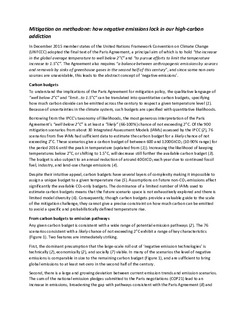| dc.contributor.author | Anderson, K | |
| dc.contributor.author | Peters, Glen Philip | |
| dc.date.accessioned | 2018-03-21T11:16:42Z | |
| dc.date.available | 2018-03-21T11:16:42Z | |
| dc.date.created | 2016-11-30T21:56:14Z | |
| dc.date.issued | 2016 | |
| dc.identifier.citation | Science. 2016, 354 (6309), 182-183. | nb_NO |
| dc.identifier.issn | 0036-8075 | |
| dc.identifier.uri | http://hdl.handle.net/11250/2491451 | |
| dc.description.abstract | n December 2015, member states of the United Nations Framework Convention on Climate Change (UNFCCC) adopted the Paris Agreement, which aims to hold the increase in the global average temperature to below 2°C and to pursue efforts to limit the temperature increase to 1.5°C. The Paris Agreement requires that anthropogenic greenhouse gas emission sources and sinks are balanced by the second half of this century. Because some nonzero sources are unavoidable, this leads to the abstract concept of “negative emissions,” the removal of carbon dioxide (CO2) from the atmosphere through technical means. The Integrated Assessment Models (IAMs) informing policy-makers assume the large-scale use of negative-emission technologies. If we rely on these and they are not deployed or are unsuccessful at removing CO2 from the atmosphere at the levels assumed, society will be locked into a high-temperature pathway. | |
| dc.language.iso | eng | nb_NO |
| dc.title | The trouble with negative emissions | nb_NO |
| dc.type | Journal article | nb_NO |
| dc.type | Peer reviewed | nb_NO |
| dc.description.version | submittedVersion | |
| dc.source.pagenumber | 182-183 | nb_NO |
| dc.source.volume | 354 | nb_NO |
| dc.source.journal | Science | nb_NO |
| dc.source.issue | 6309 | nb_NO |
| dc.identifier.doi | 10.1126/science.aah4567 | |
| dc.identifier.cristin | 1406822 | |
| dc.relation.project | Norges forskningsråd: 209701 | nb_NO |
| cristin.unitcode | 7475,0,0,0 | |
| cristin.unitname | CICERO Senter for klimaforskning | |
| cristin.ispublished | true | |
| cristin.fulltext | preprint | |
| cristin.qualitycode | 2A | |
